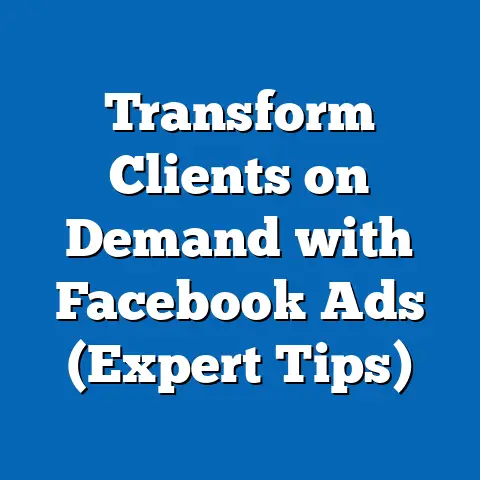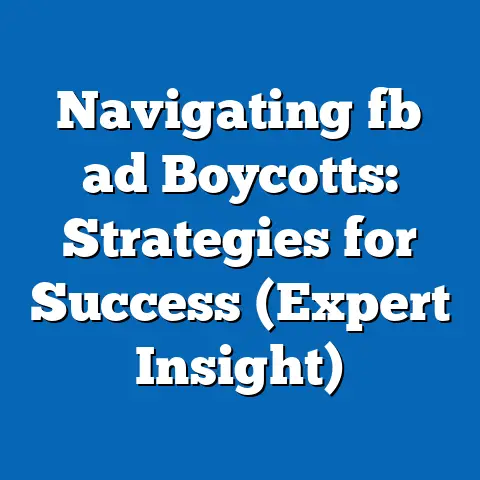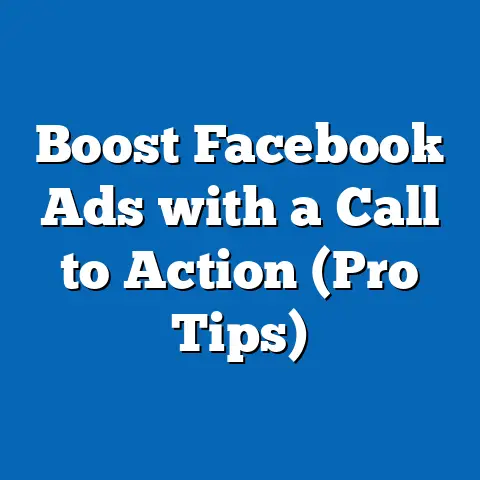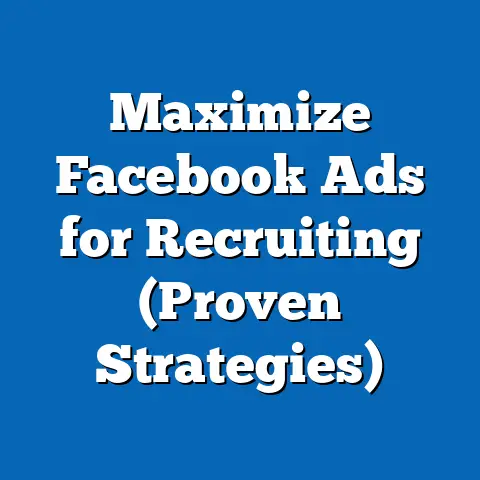Maximize App Installs with Facebook Ads (Expert Strategies)
In the past decade, the mobile app ecosystem has exploded, becoming a cornerstone of modern life and business. With over 5.7 million apps available across the Google Play Store and Apple App Store as of 2023, competition for user attention has never been fiercer. This surge is driven by the increasing reliance on smartphones, with global mobile users surpassing 5 billion, according to Statista.
Simultaneously, digital advertising has evolved into a dominant force for app promotion, with platforms like Facebook (now part of Meta) leading the charge. Facebook Ads, with its unparalleled user base of over 2.9 billion monthly active users, offers app developers and marketers a powerful tool to drive installs through precise targeting and innovative ad formats. The societal shift toward mobile-first experiences has made app install campaigns a critical strategy for businesses, from gaming to e-commerce, seeking to capture market share.
Section 1: Trends in Mobile App Install Campaigns on Facebook Ads
The Growth of App-Centric Marketing
The mobile app market has grown exponentially since the launch of the Apple App Store in 2008, transforming how businesses engage with consumers. App install campaigns on platforms like Facebook have become a primary method for reaching potential users, with global spending on mobile app advertising expected to reach $362 billion by 2027, according to AppsFlyer. This trend reflects the shift from traditional desktop-based marketing to mobile-first strategies.
Facebook Ads has been at the forefront of this transformation, offering tools like App Install Ads, which are specifically designed to drive downloads through targeted placements across Facebook, Instagram, and the Audience Network. The platform’s ability to leverage vast amounts of user data for hyper-targeted campaigns has made it a go-to choice for app marketers. In 2022 alone, Meta reported that app install ads accounted for a significant portion of its advertising revenue, underscoring their importance to both the platform and its advertisers.
Defining Characteristics of Successful Campaigns
Successful app install campaigns on Facebook Ads share several key characteristics. First, they prioritize precise audience targeting, using tools like Custom Audiences and Lookalike Audiences to reach users similar to existing app users. Second, they utilize engaging creative formats, such as video ads and playable ads, which have been shown to increase conversion rates by up to 30%, per Meta’s internal studies.
Additionally, successful campaigns often employ optimization strategies like Cost Per Install (CPI) bidding, ensuring that ad spend aligns with actual installs rather than impressions or clicks. These campaigns also adapt to platform-specific best practices, such as integrating with Meta’s SDK for accurate tracking and attribution. Together, these characteristics define a data-driven, user-centric approach that maximizes return on investment (ROI).
Societal Implications of App Install Advertising
Moreover, the dominance of platforms like Facebook in app promotion has created a digital divide, where smaller developers with limited budgets struggle to compete against well-funded competitors. This trend underscores the need for equitable advertising solutions and raises questions about the long-term sustainability of app ecosystems. As society grapples with these implications, regulators worldwide are scrutinizing digital advertising practices, with policies like the EU’s General Data Protection Regulation (GDPR) and Apple’s App Tracking Transparency (ATT) framework reshaping the landscape.
Section 2: Historical Context of Mobile Advertising and Facebook Ads
The Evolution of Mobile Advertising
Mobile advertising emerged in the early 2000s with the advent of SMS marketing, but it gained significant traction with the introduction of smartphones and app stores in the late 2000s. The launch of the iPhone in 2007 and the subsequent rise of Android devices created a fertile ground for mobile apps, prompting advertisers to explore new ways to reach users. Early mobile ads were rudimentary, often limited to banner ads with low engagement rates.
By 2010, platforms like Google and Facebook recognized the potential of mobile advertising, investing heavily in tools to capitalize on this trend. Facebook launched its first mobile ad product in 2012, coinciding with the company’s IPO and a strategic pivot to mobile-first revenue models. This period marked a turning point, as mobile ad spending began to outpace desktop advertising, a trend that continues today with mobile accounting for over 70% of global digital ad spend, according to eMarketer.
Facebook’s Role in Shaping App Install Campaigns
Facebook’s introduction of App Install Ads in 2012 was a game-changer for mobile marketers. Initially designed to help developers drive downloads, these ads evolved over time to include advanced targeting options and optimization tools. The platform’s acquisition of Instagram in 2012 and the expansion of its Audience Network further amplified its reach, allowing advertisers to promote apps across multiple touchpoints.
Significant events, such as the rollout of Facebook’s mobile SDK and the introduction of dynamic ads, have shaped the effectiveness of app install campaigns. These innovations enabled precise tracking of user behavior and automated ad personalization, boosting conversion rates. Today, Facebook Ads remains a leader in the space, though challenges like Apple’s ATT framework, introduced in 2021, have forced the platform to adapt to a privacy-first era.
These factors have created a virtuous cycle, where increased app adoption drives ad demand, which in turn fuels platform innovation. However, economic disparities between regions mean that not all markets benefit equally from these advancements, highlighting the need for localized strategies in app install campaigns. Understanding this historical and contextual backdrop is crucial for crafting effective advertising approaches today.
Section 3: Expert Strategies to Maximize App Installs with Facebook Ads
Strategy 1: Leveraging Advanced Targeting Tools
One of the most powerful features of Facebook Ads is its targeting capabilities, which allow marketers to reach highly specific audiences. Custom Audiences enable advertisers to target existing users or leads by uploading customer data, while Lookalike Audiences expand reach by identifying users similar to high-value customers. According to Meta, campaigns using Lookalike Audiences can achieve up to 50% lower CPI compared to broad targeting.
Additionally, interest-based and demographic targeting can refine audience selection, ensuring ads are shown to users most likely to install. For example, a fitness app might target users interested in health and wellness, aged 18-35, who engage with related content. Marketers should continuously test and refine audience segments to optimize performance, using A/B testing to identify the most responsive groups.
Strategy 2: Crafting Compelling Creative Content
Creative content is the heart of any successful app install campaign. Video ads, in particular, have proven highly effective, with Meta reporting that mobile app install ads using video see a 25% higher conversion rate compared to static images. Short, engaging videos that highlight an app’s core value proposition—such as a quick demo or user testimonial—can capture attention within the first three seconds.
Playable ads, which allow users to interact with a mini-version of the app before downloading, are another powerful format, especially for gaming apps. These ads can boost install rates by up to 40%, per industry reports. Marketers should also ensure that visuals and messaging align with the app’s branding and target audience, maintaining consistency across ad placements.
Strategy 3: Optimizing for Cost Per Install (CPI)
Budget optimization is critical in app install campaigns, where the goal is to achieve the lowest possible CPI without sacrificing quality. Facebook’s Campaign Budget Optimization (CBO) tool automatically allocates spend across ad sets to maximize results, while Value Optimization prioritizes users likely to engage beyond the install, such as making in-app purchases. Studies show that campaigns using Value Optimization can reduce CPI by up to 30%.
Marketers should also monitor key metrics like install rate, retention rate, and return on ad spend (ROAS) to gauge campaign effectiveness. Adjusting bids based on performance data and experimenting with different ad placements—such as Instagram Stories versus Facebook News Feed—can further drive efficiency. A data-driven approach ensures that every dollar spent contributes to measurable outcomes.
Strategy 4: Integrating Deep Linking and Attribution
Deep linking enhances user experience by directing users to specific in-app content after installation, reducing friction and increasing engagement. For instance, an e-commerce app might link directly to a product page featured in the ad. According to Branch.io, deep linking can improve conversion rates by up to 200% by creating a seamless transition from ad to app.
Accurate attribution is equally important, as it tracks which ads drive installs and subsequent actions. Facebook’s SDK and partnerships with third-party attribution platforms like AppsFlyer and Adjust provide robust tracking solutions, even in a post-ATT world. Marketers must prioritize privacy-compliant tracking methods to maintain user trust while gathering actionable insights.
Strategy 5: Adapting to Privacy Changes and Platform Updates
The digital advertising landscape is undergoing a seismic shift due to privacy regulations and platform changes. Apple’s ATT framework, which requires user consent for tracking, has reduced the effectiveness of traditional targeting on iOS devices, with opt-in rates averaging around 25%, per Flurry Analytics. Similarly, Google’s planned phase-out of third-party cookies by 2024 signals a broader move toward privacy-first advertising.
To adapt, marketers should focus on contextual targeting, which uses content and placement data rather than personal identifiers, and invest in first-party data collection through in-app prompts and loyalty programs. Meta’s ongoing updates, such as the introduction of Aggregated Event Measurement, also help advertisers navigate these changes by providing privacy-safe measurement tools. Staying agile and informed is key to sustaining campaign performance.
Section 4: Comparative Analysis Across Industries and Markets
Industry-Specific Approaches to App Install Campaigns
Different industries require tailored strategies for app install campaigns on Facebook Ads. Gaming apps, for instance, benefit from playable ads and high-frequency retargeting, as user acquisition is often volume-driven with short decision cycles. In contrast, finance and health apps prioritize trust and value, using detailed video content and testimonials to address user concerns about security and utility.
E-commerce apps often focus on driving not just installs but also in-app purchases, leveraging dynamic product ads to showcase inventory. According to a 2023 Adjust report, e-commerce apps have an average CPI of $2.50 on Facebook Ads, compared to $1.80 for gaming apps, reflecting differing user acquisition costs. Understanding these nuances allows marketers to allocate resources effectively across sectors.
Regional Variations and Cultural Factors
App install campaigns must also account for regional differences in user behavior and platform usage. In North America and Europe, high smartphone penetration and disposable income result in lower CPIs and higher ROAS, while emerging markets like India and Brazil offer vast user bases but face challenges like limited data connectivity and payment barriers. A 2022 AppsFlyer study found that CPIs in Asia-Pacific are 40% lower than in North America, though retention rates often lag.
Cultural factors, such as language preferences and social norms, further influence campaign success. For example, localized ad copy and imagery resonate better in markets with strong cultural identities, while global campaigns risk alienating diverse audiences. Marketers should adopt a glocal approach—combining global strategies with local customization—to maximize impact across regions.
Section 5: Broader Implications for Society and Business
Impact on the App Economy and Innovation
The proliferation of app install campaigns on platforms like Facebook Ads has fueled the app economy, creating millions of jobs for developers, designers, and marketers. It has also spurred innovation, as businesses compete to offer unique features and user experiences to stand out in crowded markets. However, the reliance on paid acquisition raises concerns about sustainability, as smaller developers struggle with rising CPIs and platform fees.
Furthermore, the focus on installs as a primary metric can incentivize short-term growth over long-term user value, potentially leading to apps with poor retention rates. Industry experts advocate for a shift toward lifecycle marketing, where campaigns prioritize engagement and loyalty alongside acquisition. This balance is essential for fostering a healthy app ecosystem.
Workplace and Marketing Dynamics
For businesses, mastering app install campaigns has become a critical skill in a mobile-first world, reshaping marketing teams’ priorities and skill sets. Data analysts, creative strategists, and attribution specialists are in high demand as companies seek to optimize ad performance. The integration of AI-driven tools, like Meta’s Advantage+ campaigns, is also transforming workflows by automating optimization tasks.
In the workplace, the rise of app-based services has blurred the lines between personal and professional life, with tools like Slack and Zoom relying on mobile installs for accessibility. This trend enhances productivity but also raises questions about employee privacy and work-life balance. Organizations must navigate these dynamics thoughtfully to maintain trust and efficiency.
Cultural and Ethical Considerations
Culturally, the ubiquity of mobile apps and targeted advertising has reshaped how individuals interact with technology, often fostering a sense of dependency on digital tools. The gamification of app experiences, driven by ad-driven installs, can lead to addictive behaviors, particularly among younger users. Researchers have noted a correlation between heavy app usage and mental health challenges, prompting calls for ethical advertising practices.
Ethically, the use of personal data for targeting remains a contentious issue, as users demand greater transparency and control. Marketers must balance effectiveness with responsibility, ensuring campaigns respect user consent and cultural sensitivities. As societal expectations evolve, adopting ethical frameworks will be crucial for maintaining brand reputation and consumer trust.
Section 6: Conclusion and Forward-Looking Insights
Maximizing app installs with Facebook Ads requires a multifaceted approach that combines advanced targeting, compelling creatives, budget optimization, and adaptability to privacy changes. By understanding the historical context of mobile advertising and the societal trends driving app adoption, marketers can craft strategies that resonate with diverse audiences across industries and regions. The data-driven insights and expert strategies outlined in this article provide a roadmap for success in an increasingly competitive landscape.
Looking ahead, the future of app install campaigns will likely be shaped by ongoing privacy regulations, technological advancements, and shifting user behaviors. Innovations like augmented reality ads and AI-powered personalization hold promise for enhancing engagement, but their impact remains uncertain amid evolving platform policies. Marketers must remain agile, prioritizing user-centric and ethical practices to navigate this dynamic environment.
Ultimately, the ability to drive app installs on Facebook Ads is not just a marketing challenge but a reflection of broader societal shifts toward digital connectivity. By embracing both the opportunities and responsibilities of this space, businesses can build sustainable growth while contributing to a balanced and inclusive digital ecosystem. As the mobile app market continues to evolve, staying informed and adaptable will be the key to unlocking long-term success.






